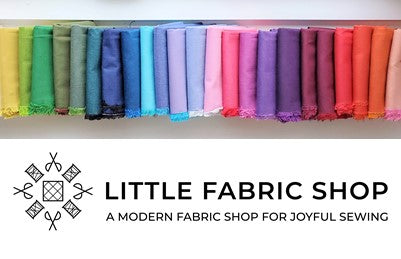Types of Cotton Fabric

We love sewing with cotton fabric! This natural fiber is great to work with and is very versatile. There are many different types of cotton fabric. To help you navigate the options, we have put together a guide with details on all the variations available in our shop. Keep reading for all of the details.
A Very Brief History of Cotton
Cotton fabric is one of the oldest fibers used for clothing. This material dates back thousands of years. Traces of this fabric have been found in caves in Mexico dating 7,000 years ago. In Pakistan, cotton was farmed and spun into clothing dating back to 3,000 B.C. By the 1500’s A.D., cotton had become a staple throughout the world. With advances in farming techniques and eventually the invention of the cotton gin in 1793 by Eli Whitney, the manufacturing of cotton cloth became significantly faster. This allowed for the textile industry to make substantial growth with the availability of larger quantities of cotton fiber.
Today, the textile industry – accounting for both natural and synthetic fibers – is a $996.3 billion (U.S. dollar) industry. Cotton fiber is the largest segment of this industry and represents 45% of sales. The largest cotton farming locations are in India, Egypt, Africa, and the Americas. The top textile exporting countries worldwide are China, European Union, India, Turkey, and the United States.
The Pros and Cons of Cotton
Why We Love Cotton
Cotton is made of natural fibers. In most cases, it is easy to care for. Most cotton fabrics can be cleaned in a washing machine and dried on a low heat setting. Cotton is also breathable and a favorite for clothing, baby garments and home goods. This fabric is also recyclable and biodegradable. Finally, cotton fabric is soft to hand, easy to dye, and durable.
Cotton Challenges
Traditional farming of cotton can lead to soil erosion and degradation if over planted. Additionally, there can be significant pollution issues with the use of pesticides and cotton can require a noteworthy amount of water to farm. This industry is working towards more sustainable farming practices. Cotton fabric is expensive compared with synthetic fabrics, it holds moisture longer, and can shrink if it is dried with a high heat.
Cotton Fabric Guide
Quilting Cotton Fabric
The largest cotton fabric category in our shop is quilting cotton. Quilting cotton is a medium weight, plain weave fabric. Plain weave fabrics are strong. The warp and weft of the threads cross at right angles to form a crisscross pattern. These fabrics hold their shape nicely and are a favorite among quilters. Designs are printed directly onto the fabric and as a result, there is a “Right Side of Fabric” and a “Wrong Side of Fabric.
Barkcloth Fabric
Barkcloth is a soft, thick, and textured fabric. This versatile fabric can be used for garments, accessories, and home décor. Our barkcloth fabric is 100% organic cotton and manufactured by Cloud 9 Fabrics.
Batik Fabric
Batik fabric originated in Indonesia. This fabric uses wax in the hand-dying process as a barrier to pigment to create beautiful and interesting designs. This fabric tends to be lighter in weight and works beautifully for both clothing and décor. Our batik fabric is part of the Alison Glass Pulsar Handcrafted Collection from Andover Fabrics.
Canvas Fabric
Canvas fabric is a heavyweight and strong fabric. Canvas can be used for paintin, boating sails, tents, backdrops, shoes, furniture, handbags, and clothing. Our canvas is 100% cotton and is available with beautiful prints or woven with linen.
Corduroy Fabric
Another strong cotton fabric is corduroy. While canvas will be more rigid, corduroy is soft. This fabric is a cousin of velvet. This ribbed fabric can come in different sized wale surfaces and has historically been used for garments. While apparel sewing is the most popular use of this fabric, bags, accessories, and home decorations work wonderfully with this fabric as well.
Flannel Fabric
When we think of cozy, winter fabric, cotton flannel fabric comes to mind first. This soft fabric is a favorite among sewists during the colder months. Flannel is a soft, medium-weight fabric that has a fuzzy finish on one or on both sides of the fabric. The nap is created by either brushing or from the loose weave. This fabric bleeds easily, so it is important to pre-wash prior to sewing.
Organic Fabric
As we shared above, one of the challenges of traditional cotton farming is the impact to the environment. Organic fabric is manufactured to a standard that addresses soil fertility, reduces the use of pesticides and fertilizers, and utilizes dyes and production methods that are not harmful to the environment. Little Fabric Shop carries organic fabric that is distributed by Cloud 9 Fabrics and Monaluna Designs.
Toweling Fabric
We carry cotton toweling fabric that is 16” wide. It is hemmed on two sides which allows for quick sewing projects when making napkins, table runners, dish towels, and placemats. Our toweling is a medium weight fabric and will have less movement than quilting cotton. Beyond the kitchen, toweling fabric is a great weight option for both bags and aprons.
Yarn Dyed Woven Fabric
Yarn dyed woven fabric is created by dying each thread prior to weaving to create the fabric rather than having a color or pattern being printed directly on top of the fabric. Different colors and patterns are created through the weaving process to create the fabric color which allows for rich and vibrant fabrics. The weave of this fabric is slightly looser than quilting cotton and as a result has a beautiful drape.
We hope you have enjoyed this cotton fabric field guide! Happy Sewing!!




